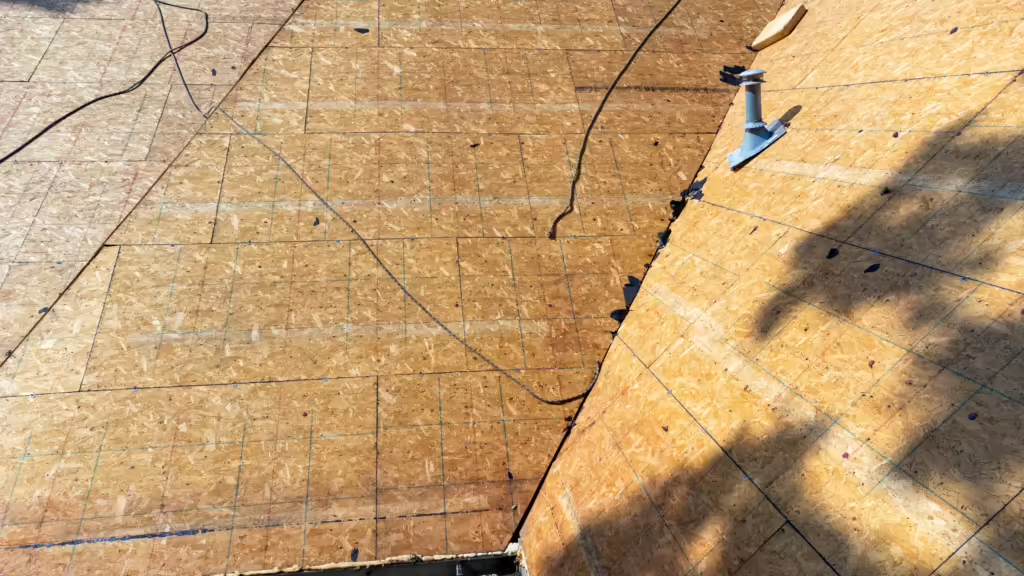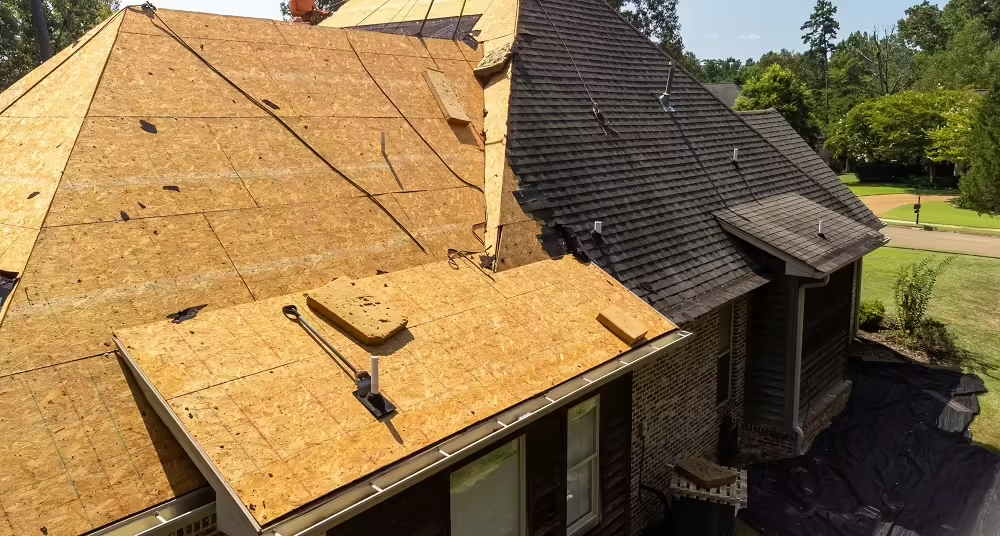Roof decking is a fundamental part of a roofing system. Acting as the base layer, it supports the roof covering materials and is made from various materials that provide structural support, insulation, and protection against weather elements. For homeowners and contractors, understanding roof decking is vital to ensure the longevity and stability of a roof.
What is the Purpose of Roof Decking?
Roof decking is the layer of material installed on the structural framework of a roof. It serves as the foundation for the roof covering, offering support and stability to the entire roofing system. The importance of roof decking cannot be overstated. It plays a crucial role in protecting your home from external elements such as weather conditions, wind, and moisture. By providing a solid base, it helps distribute the weight of the roof evenly, preventing sagging and potential damage.

Additionally, roof decking enhances the insulation and energy efficiency of your home. It acts as a barrier against heat transfer, keeping your living spaces cooler in the summer and warmer in the winter.
What is Roof Decking Made of?
Several materials are commonly used for roof decking, each with its own set of advantages and disadvantages.
Plywood Decking
Plywood’s affordability and strength make it a popular choice for roof decking.
On the plus side, plywood is cheaper compared to other options like oriented strand board (OSB). This can be a significant cost saver for larger projects. Additionally, its layered construction translates to impressive strength and stability, providing a solid foundation for your roof structure. Plywood also excels in holding nails securely, ensuring a strong and reliable bond between your shingles and the roof deck. Finally, plywood offers versatility with varying thicknesses and grades, allowing you to find the perfect fit for your specific roof design and load requirements.
It is however susceptible to moisture absorption, which can lead to warping and swelling if not properly sealed and ventilated. This warping can compromise the integrity of your roof. Additionally, prolonged exposure to moisture can make plywood susceptible to rot and mold growth. Proper ventilation and waterproofing are crucial to mitigate these risks. Plywood’s weight is another factor to consider. It can be heavier than some alternatives, adding to the overall weight of the roof structure and potentially requiring additional support in certain situations.
Oriented Strand Board Decking
Oriented strand board, or OSB, is another popular choice for roof decking, offering a compelling combination of affordability and functionality. Made from compressed wood strands, OSB is a lightweight option that boasts good structural strength. It is also treated for moisture resistance, making it suitable for use in various climates. This combination of affordability, weight, and moisture resistance makes OSB a widely used material.
However, there are some trade-offs to consider. OSB might not be as durable as plywood, especially in the long run. Additionally, while treated for moisture resistance, OSB can still swell if exposed to water for extended periods. This can be a concern in areas with frequent rain or high humidity. If these factors are a major concern for your project, plywood or other water-resistant decking materials might be a better choice.
Engineered Wood Decking
For homeowners seeking an eco-friendly option, engineered wood is a viable choice. Manufactured by bonding together strands, particles, or fibers of wood with adhesives, it is a sustainable option that offers good stability and resistance to moisture. However, it may have a higher upfront cost compared to traditional materials.
Why Roof Decking is an Essential Component for a Roofing System
Roof decking plays a vital role in the roofing system, working with other roof components to provide a durable and efficient structure. It acts as the foundation for the entire roofing system, supporting the underlayment, shingles or tiles, and any additional layers such as ice and water barriers. The quality and strength of the roof decking directly affect the stability and longevity of the entire roof.
When it comes to ventilation and insulation, roof decking is significant. Adequate ventilation prevents moisture buildup and maintains a comfortable indoor environment. Professionally installed roof decking allows for effective air circulation, helping regulate temperature and prevent mold or mildew growth. Additionally, the insulation installed beneath the roof decking minimizes heat transfer, improving energy efficiency and reducing heating and cooling costs.
Compatibility between roof decking and roofing materials is crucial for a reliable and long-lasting roof. Different roofing materials require specific types of roof decking to perform optimally. For instance, asphalt shingles typically require plywood or OSB decking, while metal roofs may need a more rigid material like metal or concrete. Consulting with a roofing professional is essential to determine the best decking material for your specific needs.
When to Replace Roof Decking
Roof decking is essential for your home’s roofing system, providing structural support and a base for the shingles or other roofing materials. Over time, roof decking can become damaged or rotten, compromising the integrity of your roof. Knowing when to replace roof decking is crucial to prevent further damage and ensure the safety and longevity of your roof.
Signs that indicate the need for roof decking replacement include sagging or uneven areas, water stains on your ceiling or walls, visible rot, mold growth, or a spongy feeling when walking on the roof. The timing for replacement depends on several factors, including the age of your roof and recent weather conditions. If your roof is nearing the end of its lifespan or has experienced severe weather, it is essential to inspect the decking for damage.
If you are planning a roof shingle replacement, consider it an opportune moment to address other roof components. This could include replacing the roof decking itself, especially if it is showing signs of wear and tear like warping, water damage, or rot. Additionally, it is wise to inspect and potentially replace any other roofing components that have reached the end of their lifespan or are compromised. For example, if your flashing (the thin sheets of metal used around roof valleys and penetrations) is cracked or rusted, this would be a prime time for a replacement to prevent future leaks.
Roof Decking Installation and Maintenance
Proper installation techniques for roof decking are crucial to ensure the structural integrity and longevity of your roof. Roof decking, also known as sheathing, provides the foundation for the roof covering. Following the manufacturer’s guidelines and local building codes is essential when installing roof decking. The material should be chosen based on factors such as climate, roof slope, and the weight of the roof covering. Common materials include plywood, OSB, and solid wood boards.
During installation, it is important to align and secure the decking panels properly to ensure a flat and even surface, preventing sagging and water pooling. Proper spacing between panels allows for expansion and contraction due to temperature changes.
Regular maintenance is key to preventing common issues with roof decking. Inspect the decking for signs of damage, such as rot, cracks, or loose panels, and promptly repair or replace any damaged sections to maintain the roof’s structural integrity. Proper ventilation is also essential, as adequate airflow prevents moisture buildup, mold growth, and deterioration of the decking material. Installing ridge vents, soffit vents, and ensuring proper insulation can help achieve proper ventilation.
Cost Considerations for Roof Decking
Several factors influence the cost of roof decking installation or replacement. Understanding these factors and budgeting accordingly can help you make informed decisions about your roofing project. The material used is one of the main cost factors. Different materials have varying costs, durability, and maintenance requirements.
An accurate estimates from reputable contractors ensure a realistic budget. Additional costs may arise if there are structural issues or if the decking needs repair or reinforcement before installation.
FAQ’s: Roof Decking
Here, we answer some common questions about roof decking.
Is roof decking the same as plywood?
Roof decking and plywood are often used interchangeably, but they are not exactly the same. Roof decking refers to the material installed on the rafters or trusses to provide a solid base for the roof covering. While plywood is commonly used for roof decking, other materials like OSB and wood planks can also be used.
What does it mean to re-deck a roof?
Re-decking a roof involves removing the existing roof covering and replacing the damaged or deteriorated roof decking. This process is necessary when the roof decking has become weak, warped, or rotted due to age, water damage, or other factors. Re-decking ensures a sturdy base for the new roof and provides an opportunity to inspect and reinforce the underlying structure.
How to tell if roof decking needs to be replaced?
Signs that indicate the need for roof decking replacement include sagging or uneven rooflines, water leaks inside the house, visible signs of rot or decay on the roof, and excessive shingle wear. It is important to have a professional roofing contractor assess the condition of your roof decking to determine if replacement is necessary.
Get a Free Quote for Your Next Roof Replacement
Are you in need of a roof replacement? Look no further than DaBella. With over X years of experience in the roofing industry, we are the experts you can trust to handle your project with precision and professionalism.
As a GAF Master Elite roofer our team of trained installers is skilled in working with GAF materials, guaranteeing a flawless installation every time. With our expertise and over a decade of experience in transforming homes, you can have peace of mind knowing that your roof replacement project is in the hands of the top roofing contractor in the nation.
Ready to get started on your roof replacement project? Get a free quote by calling us today at 844-DaBella for a free quote. Our friendly and knowledgeable team is standing by to assist you. Do not settle for anything less than the best when it comes to your roof decking. Choose DaBella for superior quality and exceptional service.

